During the entirety of his coaching career, Pep Guardiola has been associated with a 4-3-3 system. This perhaps even more than the term, tiki-taka, has defined the sides that he has coached from Barcelona to Bayern Munich and now with Manchester City. Guardiola himself, however, has always been adamant that formations are nothing more than numbers and that the tactical concepts underneath those numbers are what matters. There is a lot of truth in that but those of us that consume football through the mainstream media are told that formations are the same thing as tactics. This is not the case.
It is easy watching from the outside to get caught up in those numbers. The battle of 4-4-2 and 4-3-3, for example, is more jarring on our screens in nice graphics and suggests a real tangible difference. What if, though, one of the two strikers in the 4-4-2 had been tasked to drop deeper to link play? Does the 4-4-2 then become 4-2-3-1 or even 4-3-3 in possession? More importantly, does it matter?
The catalyst for this piece is the use of a three at the back system from Guardiola at Manchester City over the last game and a half. I have already covered the match between Manchester City and Sheffield United when City changed to a back three at half time. In my analysis, I assumed that this change was made to give City more superiority in key areas of the field, behind the United midfield. What I did not expect was for Guardiola to retain this system for City’s next match at home to Everton.
In this tactical analysis, I will break down this change of system to show that the tactical concepts used by City remain consistent regardless of whether they play with two or three central defenders.
Tactical concepts
So if formations aren’t really tactics then what are? I prefer to think of tactics within a team structure as a series of tactical concepts. These concepts are taught to the players early and often in training sessions and form the basis of how that team will play in each phase of the game. These phases can be broken down into the attacking phase, the transition from attack to defence, the defensive phase and the transition from defence to attack.
If you want a full breakdown on the concepts that Guardiola uses at City I am sure that someone has written a book about them…
In this article, I will discuss the two key concepts that the switch to three central defenders has enabled. The first of those is creating superiority between the lines. This concept is simple as City look to move the ball to players who are positioned between the lines of the opposition defensive block. Previously for City, this would be achieved by moving the two ‘8’s higher into more advanced positions. The second concept that I will display is the creation of 1v1 opportunities in wide areas.
So, if these concepts are the key to the tactical side of the game then does that mean that formations, or systems, do not matter at all? Well, no, of course not. The concepts are incredibly important but a tactically intelligent coach will use his systems to ensure that his players are occupying certain positional slots on the pitch. These positional slots then become important in relation to the structure of the opposition. It is here that we start to unravel the importance of Guardiola switching from a back four to a back three. This change of system altered the positional slots and made it easier for City to progress the ball and either find superiority between the opposition lines or create 1v1 situations in wide areas.
So, how does this actually work?
Analysis
To break this analysis down properly we will show a number of illustrations that show the concepts discussed above in action as part of an overall game plan. The first thing that we have to consider with the change to a back three is the changes to the way that City progress the ball from the back, or play out from the back.
We are all, of course, familiar with the fact that under Pep Guardiola we see Manchester City take significant risks with the ball when playing out from the back. These risks are mitigated by the fact that Guardiola and his coaching staff give clear instructions to the players on the correct passes to make and angles to use when playing out of the defensive third in this way.
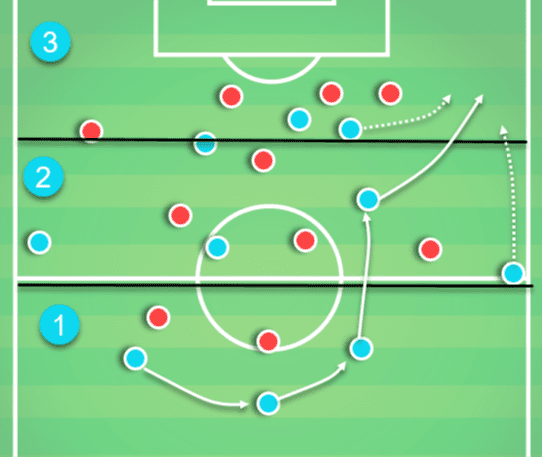
Whenever City are in possession of the ball in their defensive third, the goal remains constant – to progress the ball past the first line of pressure and into the middle third of the pitch. We will often see City recycling possession from left to right and perhaps back again across the defensive line. To some, this form of passing can seem pointless and as passing just for the sake of passing when in fact, City are looking to find the opportunity to pass vertically from the defensive third to the middle third. The sideways passes pull the opposition across the pitch and out of possession. As soon as a City defender has the option to progress the ball vertically they will take it.
With a back three City are able to occupy spaces across the first line with more width in which to recycle the ball. Combined with the fact that most opposition players will press the ball in these areas with at most two players we see that City have created superiority. The two central midfielders will then look to occupy pockets of space in which they can receive the ball and as the pass is played forward then the process will repeat itself as City look to progress the ball again into the final third.
In the example above we see that the ball is switched from left to right before the passing lane opens up for a pass into the central midfielder, usually Kevin De Bruyne. Once the ball is in the middle third one of the wide forwards, who actually take up central roles in this system, will threaten to run behind the defensive line. That threat will pin the opposition defender back and then the fullback can advance to connect play in wide spaces.
There are of course times in which the central defenders in this back three will look to play the pass straight out to the fullback. This pass, however, comes with certain rules attached that will ensure that the fullback is able to receive the ball with space and time.
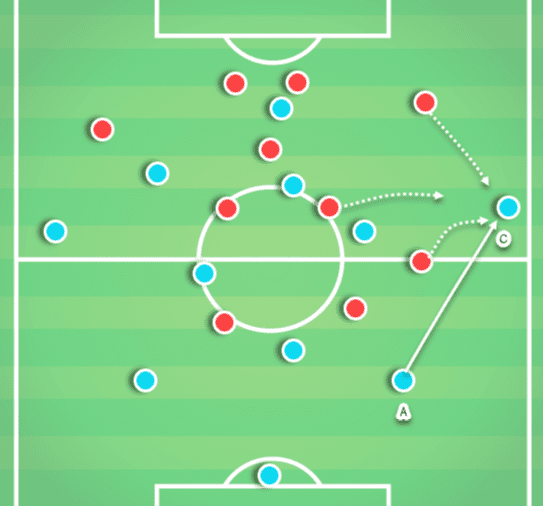
The aim is to move the ball from A to C. Relatively simple, right? The problems start when the receiving full-back is quickly pressed by the opposition who will identify passes into the wide areas as a pressing trigger, this is a simple trigger that rests on the fact that the touchline prevents the receiving player from having a full range of movement. This is why you will so often see City pass out into this area before the ball is then played back to the central defender.
This is where the positional slots in the three at the back system come into play.
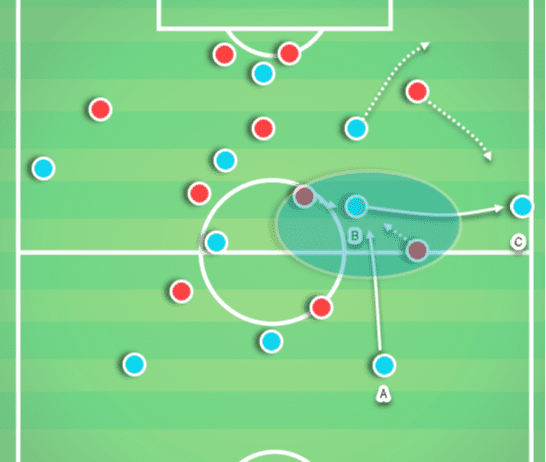
Now we can see a route from A to C but using B (Kevin De Bruyne) to ensure that the fullback is receiving the ball in time and space. With the spacing on the backline offered by the back three we tend to see the two wide defenders occupying the half-spaces.
As the ball is played forward then into the central midfielder (B) the opposition will look to engage and close down the space that he has in which to operate. As these players close down the ball they are pulled out of the wide area. The ball is then quickly played outside to the fullback (C) who now has space to receive. Now, the only player in a position to quickly close down in the wide-area being the opposition full-back we see the 1v1 that Guardiola is looking to create.
This 1v1 opportunity is further enhanced with the wide forwards, who are of course positioned centrally, being in a position to attack the space behind the opposition fullback as they move to engage the ball.
Now let’s turn our attention to the efforts of Pep Guardiola to create superiority between the defensive and midfield lines for City. Typically for City, in the 4-3-3, these spaces are occupied by the central midfielder who look to move high to receive the ball between the lines. With this change of structure, however, the wide forwards have been moved inside to create more space for the fullbacks to move high and to cause problems to the opposition.
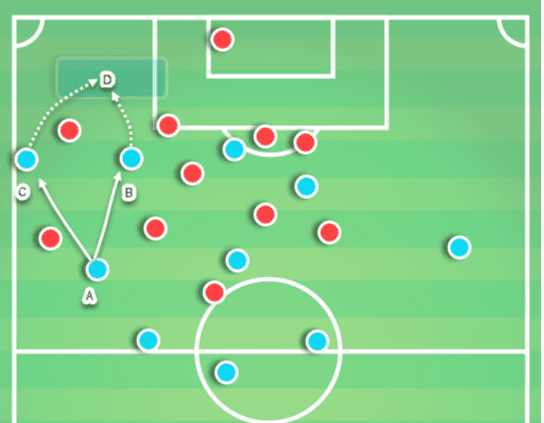
We have an example of this concept above with the ball currently in possession of one of the two central midfielders. We have seen City penetrate the defensive line from these positions on countless other occasions. The ball is, first of all, played into the final third before a combination of passes releases a runner behind the defensive line into the half-space and then crossed low across goal.
The way that this is achieved differs slightly in this system but there are two clear ways that City can attack this space and that makes it difficult for the opposition to defend. The ball can initially be played to the fullback (C) or to the advanced midfielder (B) whichever player receives the pass will look to work the ball into the space behind the defensive line (D) the other player, who does not receive the pass, will be the one to make the run behind to collect possession.
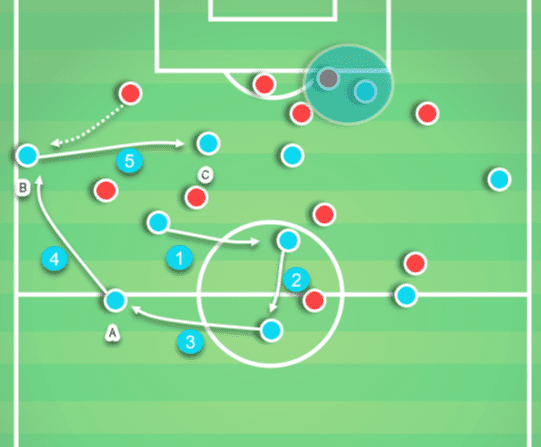
City are of course masters at creating these pockets of space between the lines and then accessing them quickly. Under Guardiola, they use passes that are quick and short in order to circulate the ball. Each pass forces an opposition defender to move out of position slightly and when we see the ball passed backwards by City it is to draw the opposition out towards them and away from their own goal. As the opposition midfield is drawn out space is created between the lines and City will exploit this space.
We see this in the example above with the new structure. The ball is initially in the midfield before travelling back to the defensive line and then out to the fullback. These passes are completed quickly and the opposition have been drawn towards the ball. The space is then opened up and the ball can be played into the advanced midfielders, interestingly, in the match against Everton we would see Gabriel Jesus take up positions away from the ball, as shown above, this created even more problems for the defensive line and spaces were opened up that could be attacked.
Conclusion
To be clear I do not expect to see City use a back three for every match from now to the end of the season. By showing a willingness to move to a back three, however, Guardiola does make it far more difficult for opposition coaches to plan for matches against City. Under Guardiola City are now well enough drilled that the Spaniard can change the positional slots of his team while keeping the tactical concepts that make them so dangerous to play against.
Formations do not matter in the way that some believe but they can be used to manipulate and exploit space, as this scout report has shown.
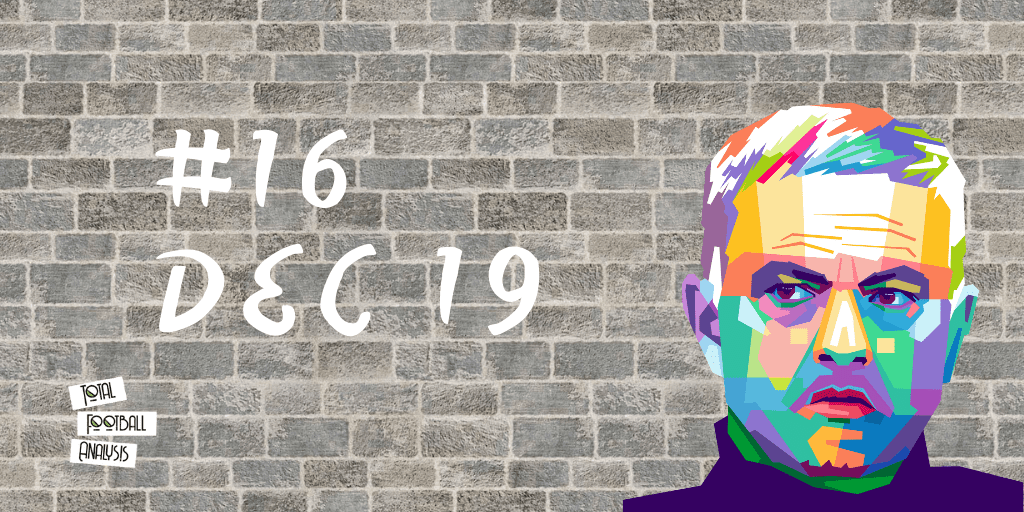
If you love tactical analysis, then you’ll love the digital magazines from totalfootballanalysis.com – a guaranteed 100+ pages of pure tactical analysis covering topics from the Premier League, Serie A, La Liga, Bundesliga and many, many more. Buy your copy of the December issue for just ₤4.99 here






Comments